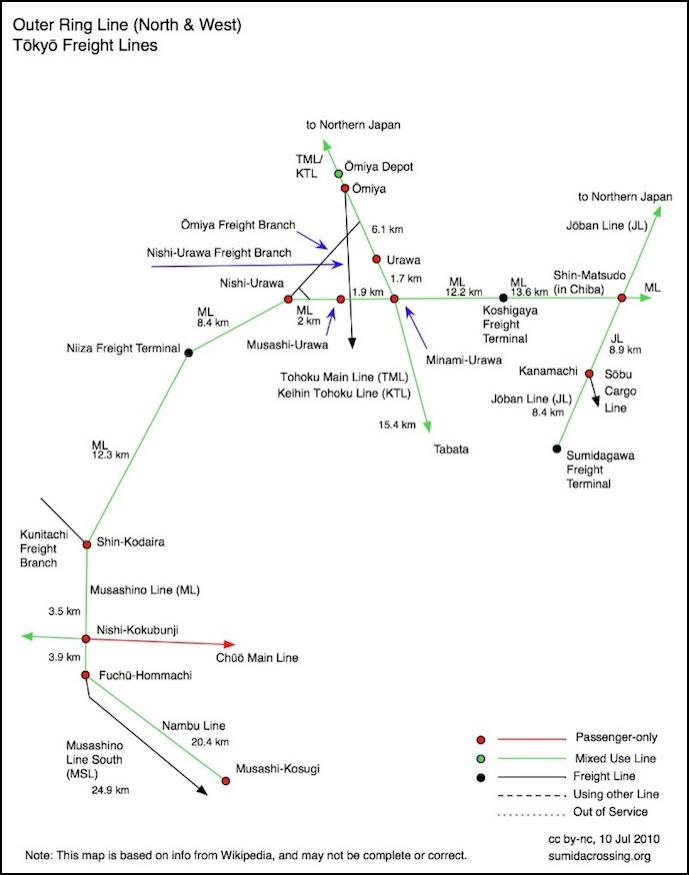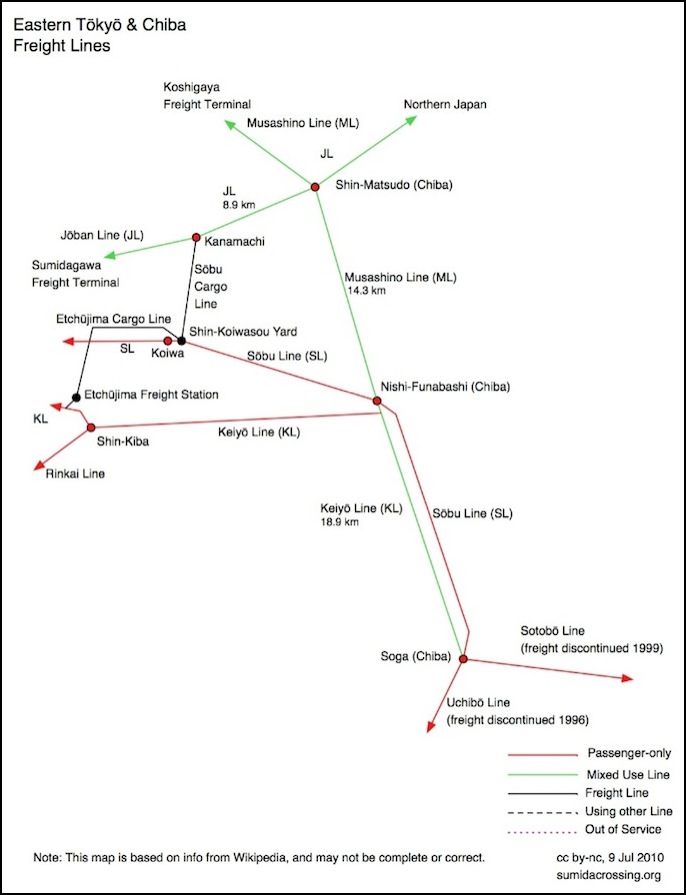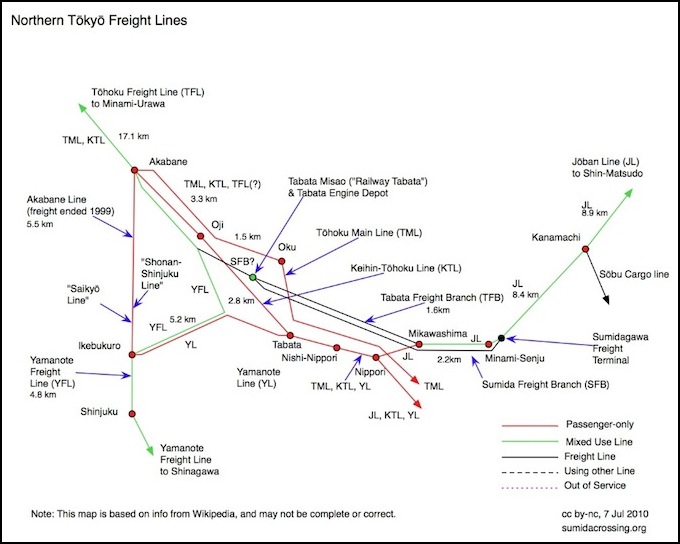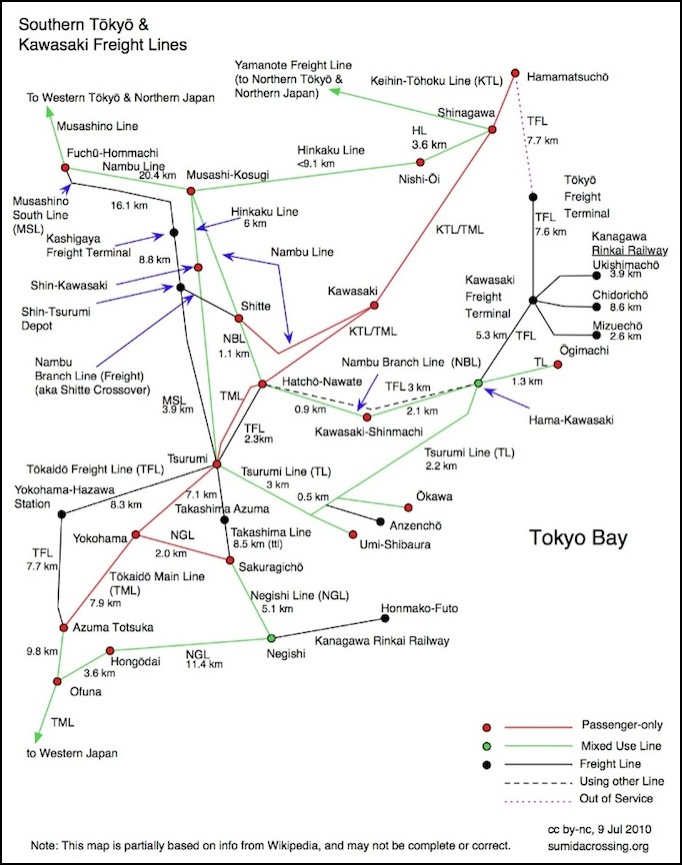Modern Tōkyō Freight Lines and Terminals
JR Freight (JRF) was created when the Japanese National Railway company was broken up in 1987. It operates dedicated freight lines and freight trains operating over mixed-use passenger/freight lines owned by other JR units. JRF operates 140 freight terminals around Japan, handling mainly container-on-flatcar trains. JRF also handles unit tanker trains and some mixed trains. A small number of other car types (boxcars, gondolas) are still in use. Most trains operate at speeds of up to 95 kph (60 mph). Some high-speed trains can operate at speeds up to 130 kph (81 mph).
Although most lines are shared with passenger trains, several freight-only branches exist (particularly around industrial port areas). The Tōkaidō Freight Line is particularly notable. This is a double-track electrified line, composed of track rights on other lines, as well as several dedicated sections that are used just for freight (although there may be one train, the Shonan Liner, that uses the freight-only section to bypass congested lines in Yokohama). This line handles freight trains headed west from the ports of Tōkyō, Kawasaki and Yokohama, as well as any trains from the west continuing to northern destinations.
Some Terminology
Cargo Line - This English phrase seems to be reserved for freight-only branch lines. The term “branch line” is sometimes used, and it’s unclear (to me, anyway) if there’s a distinction.
Freight Line - A line identified in English as a “freight line” is typically a separate set of tracks on the same route as one of the passenger lines. However, such lines may also carry some passenger trains.
The following maps illustrate the relationships between lines, stations and freight terminals. Most stations (red dots) on the map are passenger only, and freight is only handled at freight terminals (black dots). Some stations may be adjacent to other facilities not separately indicated (see text below). Scale and geographic orientation are only approximate; this isn’t quite an arbitrary schematic, but it’s not a scale map either.




Note: the above maps show current freight lines, and omit most of the now passenger-only lines formerly used for freight.
Freight Lines and Terminals
In Tōkyō, freight service into and through the central portion of the city ceased c. 1997 - 1999, although the railyards weren’t formally closed until c. 2000. This was partly due to increasing use of containerization, allowing freight to move to/from suburban truck terminals, and partly due to a long-term trend to shift freight away from the very heavily used central passenger lines, both for safety and capacity reasons. Even before this, in 1985, Japan National Rail had largely discontinued freight other than unit trains with the closure of the marshallng yards. The conversion of former industrial areas to commercial and residential use likely also contributed, as most remaining freight appears to concentrate on the port facilities south of the city center, near Kawasaki (as well as in Kawasaki and south into Yokohama). Significant freight use appears to remain on the Yamanote Freight Line (the inner belt line west of the city) to several radial lines, and the Sumidagawa (Sumida River) containter terminal on the north side of the city is a major train-to-truck terminus, located near the Tabata Depot engine servicing facility at the formal northern end of the Yamanote Freight Line.
Chūō (Rapid) Line - Although the Chūō Line within the city is no longer used for freight, I’ve seen video showing freight traffic on the Chūō Rapid Line as late as 1990, between Suidōbashi and Iidabashi stations (between Tōkyō and Shinjuku). This is well after the fire (see Yamanote Freight Line, below) said to have caused freight traffic to be shifted off the central Tōkyō lines. I suspect the freight was removed c. 1999 - 2000, with the opening of the Keiyō Freight Line, which with the existing Musashino Line took over traffic formerly on the Sōbu (and by implication also the Chūō) Line.
Etchūjima Cargo Line - A former freight line connected to the Sōbu line at Kameido (passenger) station. Now used for a welded rail ship terminal served by JR East maintenance trains. The line closed to freight in 1997 or 2000, and was reopened for maintenance trains in 2005(need to confirm date). See the Non-Freight Lines page for a longer description.
Hamamatsuchō Station - A passenger station, and the formal starting point of the Tōkaidō Freight Line. Freight trains headed north originally operated south from Hamamatsuchō to Shinagawa to access the Yamanote Freight Line. As of 1996 these trains were re-routed to use the Musashino Line, or to access the Yamanote Freight Line via the Nambu and Hinkaku lines, and the section from Hamamatsuchō to the Tōkyō Freight Terminal was abandoned, and is reportedly to be re-used for a subway line.
Iidacho Station - As noted above, this was a freight station on the Chūō / Chūō-Sōbu line in central Tōkyō that closed c. 2000. At one time it had also been a passenger station, but most of that relocated to the adjcent Iidabashi station when it was built, and the rest was later eliminated to allow the widening of the line from two to four tracks. In it’s final years, it largely served trains of newsprint (which would have been in WAMU unit trains).
Japan Rail Freight (JR貨物, JR Freight) - The company that operates most freight trains in Japan is JR Freight, which inherited the freight business, rolling stock and dedicated freight lines when the Japan National Railway (JNR) was broken up into separate operating companies in 1987. JRF operates several freight terminals in and around Tōkyō, and has operating rights over most JR narrow-gauge lines.
Kajigaya Freight Terminal - A freight terminal, reportedly on the Musashino South Line, however using Google Maps, the terminal appears to be on a line that crosses the MSL without a connection (the Tōkyū Den-en-toshi Line). The terminal serves local industries, and also handles hazardous waste (or perhaps garbage, the machine translation isn’t too clear).
Kanagawa Rinkai Railway - A freight-only port railway (“Rinkai” means “waterfront”) which operates four lines. Three of these connect to the Kawasaki Freight Terminal and handle mainly petroleum products, and the fourth connects to the Negishi line at Negishi, handling mainly containers from the Port of Yokohama.
Kawasaki Freight Terminal - A freight terminal in the Shiohama section of Kawasaki. There is an underwater freight-only tunnel leading north from here to the Tōkyō Freight Terminal. There are branches out to several of the adjacent artificial islands where there are port facilities served by the Kanagawa Rinkai Railway, and a connection to the Tsurumi line (which also serves port facilities on several artificial islands) at Hama-Kawasaki Station.
Keiyō Line Freight Route - Freight service began in 2000 from Nishi-Funabashi (Musashino connection) to Soga, apparently replacing previous use of the Sōbu line. At about the same time, freight service on the lines beyond Soga was discontinued. There was an earlier Keiyō Freight Line serving the waterfront areas at the north end of Tokyo bay, abandoned in 1983 and re-used for the Rinkai line (subway) right of way between Shin-Kiba and Shinonome.
Koshigaya Freight Terminal (越谷貨物ターミナル駅) - A freight terminal in Koshigaya, Saitama Prefecture, on the Musashino Line. It handles containers, boxcars of paper, and hazardous waste.
Lidamachi Station (飯田町駅) - Former JRF station on the Chūō Rapid Line (connected to the westbound line) between Suidōbashi and Iidabashi passenger stations, and thus a bit west of Ochanomizu. Originally a freight yard, it was last used as Iidacho Station, a terminal/warehouse facility for delivery of newsprint paper, which closed in 1999. That date tends to reinforce the above timeline for removal of freight from the Chūō line. The reason given for closure is increasing use of containers and transfer of the newsprint traffic to suburban locations. It is described as the last freight station inside the Yamanote line, and interestingly was an elevated station, raised above the level of surrounding streets (because the Chūō Line is elevated there). The old yard was redeveloped, and one of the buildings was the JR Freight headquarters, although that appears to have since relocated. A small rail facility remains at the site, with a couple of sidings and some cranes of the type used for handling welded rail. It’s unclear if this is a JR East or JRF facility.
Musashino Line (武蔵野線) - The “outer ring line” opened in 1973, diverting much freight traffic that had used the Yamanote Freight Line and other lines in central Tōkyō. The mixed-use portion is a beltway line that runs from Fuchū-Hommachi Station west of central Tokyo all the way to Chiba prefecture, east of central Tokyo, at a distance of about 20km from the center, where it connects to the Keiyo line, serving the north edge of Tōkyō Bay. At the west end it connects to both the Nambu line and the Musashino South Line.
Musashino South Line - This freight-only extension of the Musashino line parallels the Nambu line, and extends from Fuchū-Hommachi Station to Tsurumi Station via Shin-Tsurumi Depot, where it connects to the Hinkaku Line portion of the Tōkaidō Main Line. It handles trains to the north from the Tōkyō Freight Terminal (as does the Nambu line).
Nambu Line - This line handles trains headed north from Tōkyō Freight Terminal (as does the Musashino South Line).
Nambu Branch Line (南武線支線) - The Shitte to Hatchōnawate Station section is used for freight. From Hatchōnawate to Hama-Kawasaki this is considered the Tōkaidō Freight Line, although trains may actually use the Nambu Branch Line tracks (this isn’t clear).
Nambu Line Branch Line Freight (南武線貨物支線) - A Shitte to Shin-Tsurumi Depot segment allowing access from the Musashino South Line to the Nambu Freight Line and thus to the northern section of the Tōkaidō Freight Line.
Negishi Line - The Negishi Line forms a portion of the Shonan-Shinjuku Line for passenger service, but is also “heavily used” by freights. Wikipedia claims it connects to the Tokaido Freight Line at Hongōdai, but looking at Google maps the lines appear to connect slightly further south, at Ofuna.
Niiza Freight Terminal (新座貨物ターミナル駅) - A freight terminal in Niiza on the Musashino Line. It handles containers, WAMU 80000 boxcars of paper products, and hazardous waste from local industries. Its location provides access to the Kanetsu Expressway.
Oi District Authority - An assignment point for train drivers on the south side of Tokyo, as well as the point of assignment for the M250 freight EMUs.
Ōmiya Depot - Located in Saitama Prefecture, just north of Tōkyō, Ōmiya Depot services trains on the Tōhoku Main Line. Ōmiya was formerly also the site of a freight yard, but this land has been redeveloped into commercial buildings.
Onagigawa Freight Station - A former freight yard on the Etchūjima line, it closed in 2000.
Shinagawa Station - A passenger station and Japan’s oldest railway station, located in Minato ward. Notable for freight as the southern terminus of the Yamanote Freight Line, but not itself a freight station. Just south of the new Shimbashi Station (see Shidome Station). [confirm YFL actually goes here; Japanese WP says so]
Shinkane Freight Line - See Sōbu Cargo line.
Shin-Koiwasou Marshaling Yard - A former freight terminal in Katsushika ward, which appears to have been relegated to serving maintenance trains after freight was shifted off the Sōbu line in central Tōkyō. It is noted as having closed (for freight) in 1997.
Shidome Station - Formerly the name of a freight yard in Minato ward, near Ginza, in central Tōkyō, which had originally been named Shimbashi Station. Shiodome Station closed in 1986. This station was the site of the zero mile marker for the Tōkaidō Main Line. The name Shiodome is now applied to a nearby passenger station. A non-rail development is now located on the former site of Shidome Station. See Shinagawa Station.
Sōbu Cargo line - (anglicized as the “Shinkane freight line”) A freight-only electrified line that runs north from the Sōbu line at Shin-Koiwasou Marshaling Yard to join the Jōban line at Kanamachi station, about 6.6km away. For some reason machine translations of this line come out as “New Gold Line”. See the Non-Freight Lines page for a longer description.
Sotobō Line - Freight service from Soga was discontinued in 1999.
Sumidagawa Freight Terminal (Sumida River Station, 隅田川駅) - Located on the Jōban line north of Ueno station. This apparently connects to the Yamanote Freight Line via Tabata (exactly how is unclear, as there are no tracks from Tabata to where the Freight Line tracks diverge from the Yamanote Line just south of Tabata; it is likely that a reverse move via Oji is required), as well as serving trains to the north on the Jōban line. A single track connects Sumidagawa Station to Tabata Misao station. The terminal handles both container traffic as well as ordinary freight cars (primarily boxcars used for paper, and specialized hazardous waste cars).
Sumidagawa Freight Line - Unclear what this refers to (one wikipedia entry says it’s a common-use name for the Joban Freight Branch). It is probably the single track paralleling the Joban line on the south side from Sumidagawa Freight Terminal to Tabata Engine depot via Mikawashima (at the end of the Tabata Freight Branch). Or it might just be the track from Sumidagawa to Mikawashima, but that appears to be too short to match the reported length of 5.7 km. Compared to the 1.6 km of the Tabata Freight Branch, this suggests that the name could apply to the total distance from Sumidagawa Freight Terminal to Oji, where the freight tracks appear to join with those of the Yamanote Freight Line.
Tabata - Tabata is the name of both the passenger station (on the Yamanote and Keihin-Tohoku lines) and the adjacent railway yard. Although this is largely a passenger train yard (the Oku Vehicle Center), there are also an engine-servicing facilities for passenger and freight locomotives there, and a small number of tracks which could potentially be used for freight (but it is not a container terminal facility, see below). This seems to be the yard noted as “Railway Tabata” in machine-translations as one end of the Yamanote Freight Line, although the line does not directly access the yard; a reverse move would be needed).
Tabata Engine Depot (田端機関区) - This is the depot located between the Shinkansen yard and the passenger train yard at Tabata. It appears to primarily exist to service locomotives used to haul passenger coaches, but also supports freight locomotives.
Tabata Freight Branch - The line extending from Mikawashima station to the Tabata yard. This appears to be a freight-only branch. It is unclear if this name refers to the single track that connects to the Joban line on the north side of Mikawashima, or if it also includes this portion of the south track that continues on to Sumidagawa Freight Terminal (I suspect it’s just the former).
Tabata Misao Station (田端操駅) - Formerly a container freight terminal (it closed in 2007 for the second and last time) it is now home to just an engine depot and freight operations office (the latter part of the Tabata Operations Office). Some or all of these activities are due to transfer to Sumidagawa (Sumida River) Station in 2012, as part of its upgrade work, to eliminate extra moves between the two locations, which has hit capacity limits on the single track linking them.
Tabata Operations Office (田端運転所) - The Tabata Operations office services primarily passenger trains, and is located adjacent to the Tabata Misao Freight engine servicing facility (or the two are part of one facility; that isn’t clear to me). Freight locomotives operating in the district include DE10, EF81, EF64, EF65-1000 and EH500 and I have seen pictures of all of these, but no others, in the yard.
Takashima Line (高島線) - Freight-only line from Tsurumi Station (Tokaido Freight Line) to various port terminals in the Kanagawa and Naka wards of Kawasaki. However, it appears that most of these have been abandoned (some quite long ago), and only Takashima Azuma remains active (and the line is double-tracked from there to Tsurumi, suggesting little use is made of the link to the Negishi line at southern end of the line).
Tōhoku Freight Line - This appears to be the separate tracks paralleling the Tōhoku Main Line north of Akabane (and possibly extending to meet the Yamanote Freight Line and Tabata Freight Branch at Oji station just south of there, the endpoint isn’t clear.
Tōkaidō Freight Line (東海道貨物線) - This line runs from the Tōkyō Freight Terminal (the formal origin is Hamamatsuchō, but this segment has been abandoned) and Kawasaki Freight Terminal to Tsurumi and points south/west. An underwater tunnel connects the Tōkyō and Kawasaki freight terminals. This line handles trains headed west from Tōkyō, and is also used to connect to the Musashino or Nambu lines for trains headed north. South of Tsurumi, most of the 16 km section through Yokohama is underground in tunnels, surfacing primarily for the Yokohama-Hazawa Freight Station. Overall, over 23 km of the line is underground. An underground connection between Yokohama-Hazawa and the Sagami Railway Main Line at Negishi station is under construction for opening in 2015, but this appears to only be for passenger service. The undeground section through Yokohama is apparently used by one passenger train, the Shonan Liner, to relieve congestion on other lines; there are no active passenger stations on this line.
Tōkyō Freight Terminal - Located adjacent to the Oi Rail Yard (Shinkansen maintenance facility) on an artificial island just north of Haneda airport, the Tōkyō Freight Terminal mainly handles freight to and from western Japan, and is one terminal of the 130 kph (81 mph) M250 Super Rail Cargo EMU container train. However, some trains to the north also use this yard, via the Musashino line. JRF also operates a Rail Carriage Technology Research Center at the facility. The facility opened in 1973, and as containerized traffic grew it gradually eclipsed the general-freight terminal at Shidome in central Tōkyō, which closed in 1986. A freight-only tunnel leads underwater south from here to the Kawasaki Freight terminal. This is also the site of the Oi District Authority, primarily a base of operations for locomotive drivers, but also the point of assignment of the M250 freight EMUs.
Toyota Longpass Express - The Toyota Longpass Express is a 100 kph unit container train that runs daily between Morioka Terminal Station in Iwate (in northern Japan) and Nagoya South Freight Station in Aichi (in western Japan); a trip of 15-20 hours. In the Tōkyō region it uses the Tōkaidō line via Shin Tsurumi station to the Musachino line to Omiya yard via the Utsunomiya line
Tsurumi Line - The Tsurumi line (which is composed of several branches terminating on artificial islands on the edge of Tōkyō Bay) serves several petroleum storage facilities, and other commercial operations. It connects to the Nambu Branch Line and the Tōkaidō Freight Line at Hama-Kawasaki.
Uchibō Line - Freight service from Soga was discontinued in 1999.
Yamanote Freight Line - An “inner beltway” line to the west of central Tōkyō, this mixed-use line is parallel to the Yamanote Line, and serves Shinagawa Station (in Minato ward, on the Tōkaidō Main Line), Shinjuku Station and Tabata Misao Station (sometimes translated as “Railway Tabata”), covering a distance of 20.6km. Although the majority of traffic is now passenger, this line is still used for some freight. Wikipedia states that an “explosion” on the Yamanote Freight Line in Shinjuku in 1967 led to diversion of freight traffic from the line, but no other source for this is known and planning of the Musashino line had been in progress for some time before that. Also, there is some indication that the Yamanote Freight Line is still used for some freight traffic (which is not necessarily contradictory; hazardous freight such as tanker trains may have been diverted). Some confirmation of this (with slightly differing detail) has been found: a JNR freight train carrying jet fuel to the Tachikawa U.S. air base derailed on the Chūō Rapid line (not the Yamanote Freight Line, but adjacent to it) in or near Shinjuku station in August, 1967 (possibly August 8) and caught fire. As this was fuel for aircraft used in the Vietnam war, a contentious issue in Japan at the time, it was a significant event, and apparently served as inspiration for a riot a year later.
Yokohama-Hazawa (Freight) Station (横浜羽沢駅) - A container terminal on the Tōkaidō Freight Line.
References
Satellite imagery from Google Earth and Google Maps was used to check track and yard connections where possible, although this has not been done for every line referenced here.
Japan Freight website.
JR Freight timeline in 20th anniversary JR Bulletin #60 (PDF).
Rise of the Non Governmental Activities in Japan, MIT Lecture slides (PDF)
Science Links article summary on development of the M250.
Wikipedia pages for: Akabane Line, Jōban Line, Keihin-Tōhoku Line, Kanagawa Rinkai Railway, Keiyō Line, Nambu Line, Saikyō Line, Tōhoku Main Line, Tsurumi Line, and Yamanote Line.
Japanese Wikipedia pages:
Kajigaya Freight Terminal Station.
Koshigaya Freight Terminal Station.
Keiyo Line.
Musashino.
Niiza Freight Terminal.
Oi District Authority.
Oku Vehicle Center.
Shinkinkamotsusen (Sobu Line freight branch).
Shin-Koiwasou Station. (or possibly Shin-Koiwa Station, it’s unclear)
Shonan Liner.
Sotobō Line.
Sumida River Station.
Tabata Engine Depot.
Tabata Misao Station.
Tabata Operations Office.
Tabata Station.
Takashima Line.
Tōkyō Freight Terminal.
Tōkyō Outer Ring Line.
Tōkaidō Freight Line.
Toyota Long Pass Express.
Uchibō Line.
Yamanote Line (includes Yamanote Freight Line).
Yokohama-Hazawa Station.
Shinjuku Station profile with reference to the 1967 fire. However, this appears to be a verbatim quote of the wikipedia text (as are all other references I’ve found other than the one below).
Some notes on a Japanese novel also mention the Shinjuku fire, with the addition of a date (August 8, 1967) and time (2 AM), and additional comments. While not an authoritative source, it does contain more information that the Wikipedia reference.




